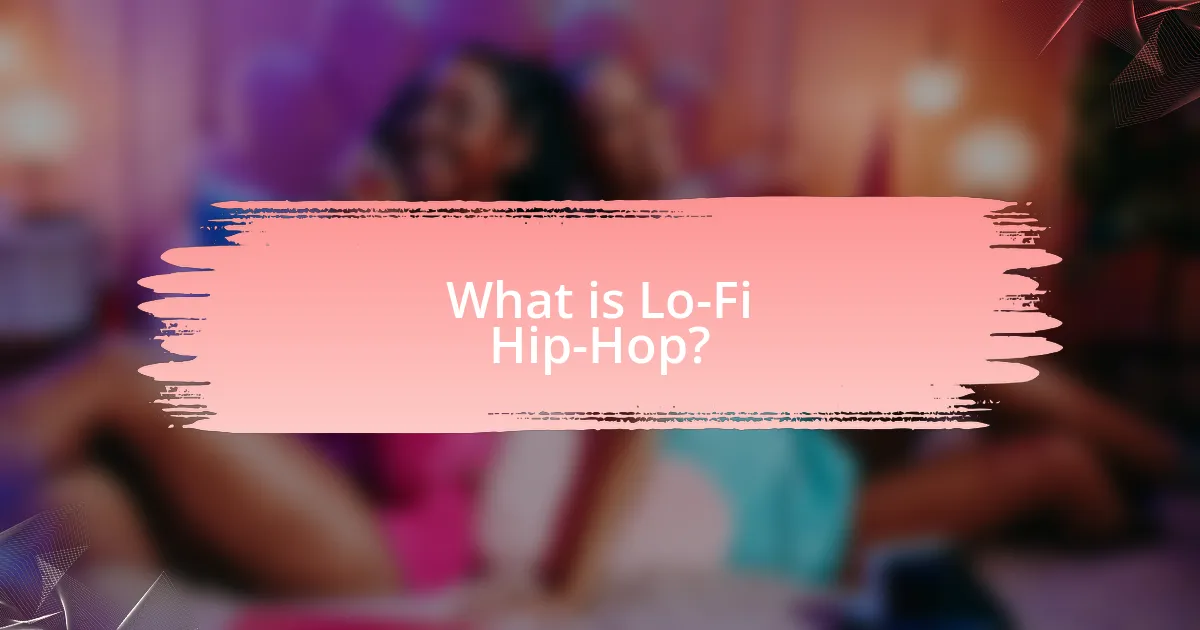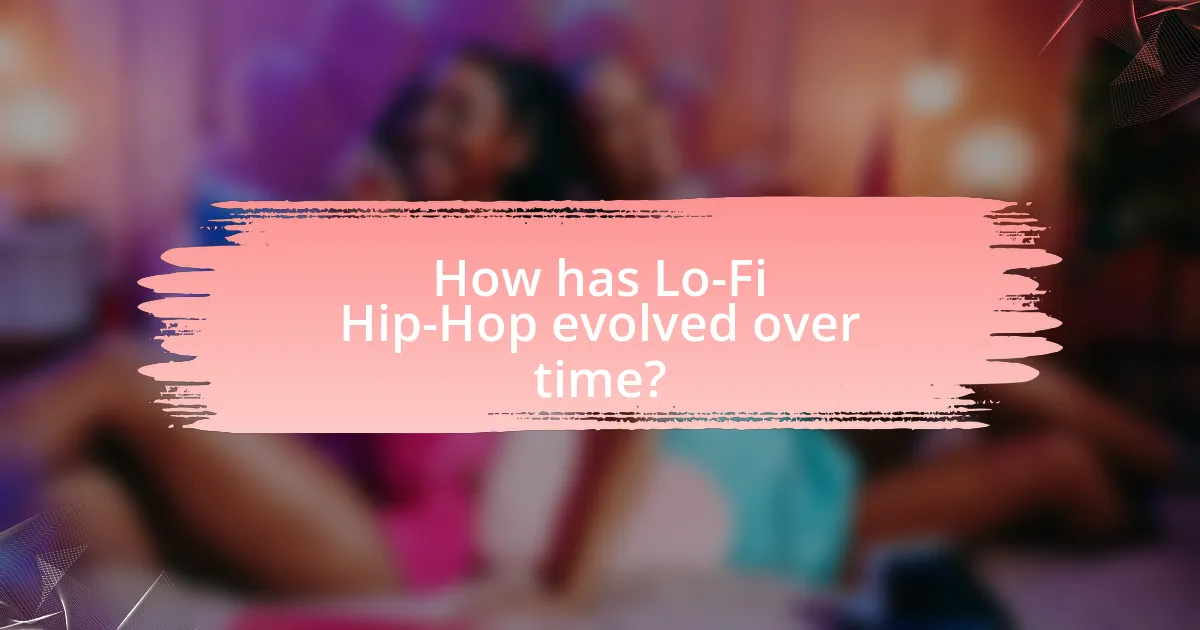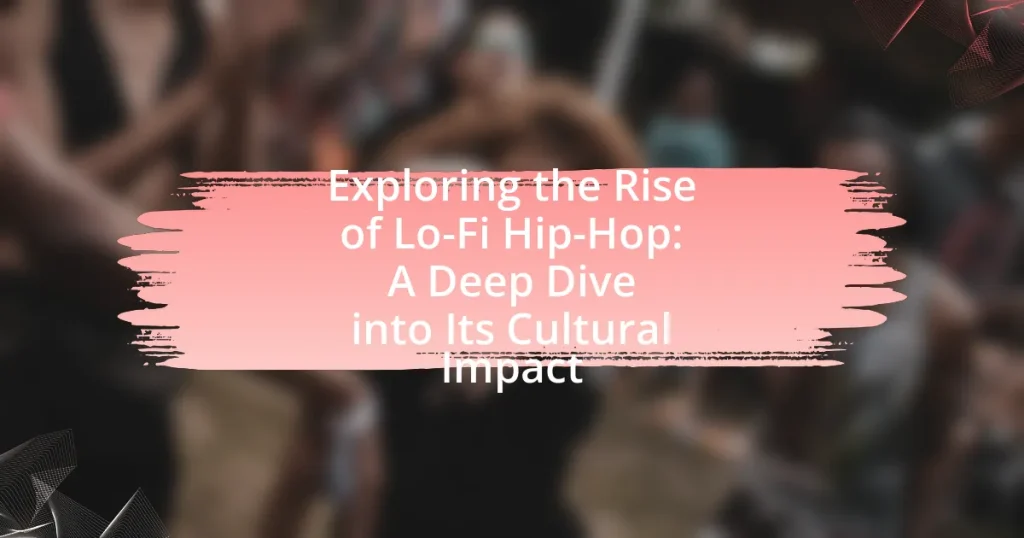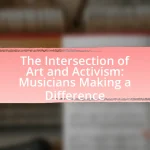Lo-Fi Hip-Hop is a subgenre of hip-hop music known for its relaxed beats, ambient sounds, and nostalgic samples, characterized by intentional imperfections in sound quality. Originating in the late 1980s and early 1990s, it gained popularity in the 2010s through digital platforms like YouTube and SoundCloud, becoming a cultural staple for study and relaxation. The article explores the genre’s origins, key artists, defining characteristics, and its evolution over time, as well as its cultural impact, audience demographics, and therapeutic benefits. Additionally, it examines the role of technology and social media in the genre’s rise and discusses future trends and emerging artists shaping its direction.

What is Lo-Fi Hip-Hop?
Lo-Fi Hip-Hop is a subgenre of hip-hop music characterized by its relaxed beats, ambient sounds, and often nostalgic samples. This genre typically features imperfections in sound quality, such as background noise or distortion, which contribute to its laid-back aesthetic. Lo-Fi Hip-Hop gained popularity in the 2010s, particularly through online platforms like YouTube and streaming services, where channels dedicated to this style, such as “Lofi Girl,” have amassed millions of listeners. The genre is often associated with study and relaxation playlists, reflecting its cultural impact as a soundtrack for focus and tranquility in modern life.
How did Lo-Fi Hip-Hop originate?
Lo-Fi Hip-Hop originated in the late 1980s and early 1990s as a subgenre of hip-hop characterized by its relaxed beats and imperfect sound quality. This genre emerged from the underground music scene, influenced by jazz, ambient music, and the DIY ethos of independent artists. The use of sampling from vinyl records, combined with the aesthetic of low-fidelity production, contributed to its distinct sound. Notably, artists like J Dilla and Nujabes played pivotal roles in shaping the genre, blending smooth melodies with hip-hop rhythms, which laid the groundwork for the Lo-Fi movement that gained popularity in the 2010s through platforms like YouTube and SoundCloud.
What cultural influences contributed to the emergence of Lo-Fi Hip-Hop?
The emergence of Lo-Fi Hip-Hop was significantly influenced by the aesthetics of 1990s hip-hop, jazz, and electronic music. This genre draws heavily from the sampling techniques prevalent in hip-hop, where artists would incorporate snippets of older tracks, particularly jazz and soul, to create a nostalgic sound. Additionally, the DIY ethos of underground music scenes, along with the rise of digital technology and platforms like Bandcamp and SoundCloud, facilitated the production and distribution of Lo-Fi tracks. The cultural appreciation for imperfections in sound, often referred to as “imperfectionism,” also played a crucial role, as artists embraced low-fidelity recordings to evoke a sense of warmth and authenticity.
Who were the key artists and pioneers in the early days of Lo-Fi Hip-Hop?
The key artists and pioneers in the early days of Lo-Fi Hip-Hop include J Dilla, Nujabes, and MF DOOM. J Dilla, known for his innovative production techniques, significantly influenced the genre with his album “Donuts,” released in 2006, which showcased a unique blend of samples and beats. Nujabes, a Japanese producer, is celebrated for his smooth, jazzy soundscapes, particularly in his work on the “Samurai Champloo” soundtrack, which helped popularize Lo-Fi aesthetics. MF DOOM, with his intricate lyricism and unconventional beats, contributed to the genre’s underground appeal, particularly through his album “Madvillainy,” released in 2004. These artists laid the groundwork for Lo-Fi Hip-Hop, shaping its sound and cultural significance.
What are the defining characteristics of Lo-Fi Hip-Hop?
Lo-Fi Hip-Hop is characterized by its relaxed beats, ambient soundscapes, and the intentional inclusion of imperfections such as vinyl crackles and background noise. These elements create a nostalgic and calming atmosphere, often used for studying or relaxation. The genre typically features slower tempos, jazzy samples, and minimalistic instrumentation, which contribute to its laid-back vibe. Additionally, Lo-Fi Hip-Hop often incorporates visual aesthetics from anime and retro culture, enhancing its appeal within online communities. The genre’s rise in popularity can be attributed to platforms like YouTube, where channels dedicated to Lo-Fi mixes have garnered millions of views, demonstrating its cultural impact and widespread acceptance.
How does the production style differentiate Lo-Fi Hip-Hop from other genres?
Lo-Fi Hip-Hop’s production style is characterized by its use of low-fidelity sound quality, which sets it apart from other genres. This genre often incorporates elements such as vinyl crackle, tape hiss, and ambient noise, creating a warm, nostalgic atmosphere that contrasts with the polished production typical of mainstream music. The intentional imperfections in Lo-Fi Hip-Hop, such as off-beat rhythms and sampled sounds from various sources, contribute to its unique aesthetic, making it feel more organic and relatable. This approach is supported by the genre’s roots in DIY culture and the use of affordable recording equipment, which emphasizes accessibility and creativity over technical precision.
What themes and motifs are commonly found in Lo-Fi Hip-Hop music?
Lo-Fi Hip-Hop music commonly features themes of nostalgia, relaxation, and introspection. These themes are often conveyed through the use of sampled sounds from vintage records, ambient noise, and soft beats, creating a calming atmosphere that encourages reflection. The motif of urban life is also prevalent, as many tracks incorporate sounds from city environments, such as rain or street noise, which evoke a sense of place and experience. Additionally, the aesthetic of imperfection, characterized by vinyl crackles and tape hiss, reinforces the genre’s embrace of authenticity and emotional depth. This combination of elements contributes to the genre’s appeal as a backdrop for studying, working, or unwinding.

How has Lo-Fi Hip-Hop evolved over time?
Lo-Fi Hip-Hop has evolved from its origins in the 1990s as a niche genre characterized by low-fidelity sound quality and sampling techniques to a mainstream phenomenon recognized for its calming and atmospheric qualities. Initially influenced by genres like jazz, ambient, and electronic music, Lo-Fi Hip-Hop gained traction through platforms like YouTube and SoundCloud, where artists began to share their work widely. The genre’s popularity surged in the 2010s, particularly with the rise of 24/7 Lo-Fi streams, such as the “Lo-Fi Hip-Hop Radio – Beats to Relax/Study To,” which became a cultural staple for students and creatives seeking background music. This evolution reflects a broader trend in music consumption, where digital platforms have democratized access to music production and distribution, allowing diverse artists to contribute to the genre’s growth.
What role has technology played in the rise of Lo-Fi Hip-Hop?
Technology has been instrumental in the rise of Lo-Fi Hip-Hop by providing accessible tools for music production and distribution. Digital audio workstations (DAWs) like Ableton Live and FL Studio enable artists to create complex soundscapes with minimal resources, democratizing music creation. Additionally, platforms such as SoundCloud and YouTube facilitate the sharing of Lo-Fi tracks, allowing artists to reach global audiences without traditional record label support. The proliferation of affordable recording equipment and software has further lowered barriers to entry, enabling a diverse range of creators to contribute to the genre. This technological landscape has fostered a vibrant community around Lo-Fi Hip-Hop, characterized by collaboration and innovation.
How have digital platforms influenced the distribution of Lo-Fi Hip-Hop?
Digital platforms have significantly influenced the distribution of Lo-Fi Hip-Hop by providing accessible channels for artists to share their music globally. Platforms like YouTube, SoundCloud, and Spotify have enabled independent artists to upload their tracks without the need for traditional record labels, democratizing the music distribution process. For instance, the YouTube channel Lofi Girl has amassed millions of subscribers and streams, showcasing how digital platforms can create dedicated audiences for Lo-Fi Hip-Hop. Additionally, the algorithm-driven nature of these platforms helps in promoting tracks to listeners who enjoy similar genres, further enhancing the reach and popularity of Lo-Fi Hip-Hop.
What impact has social media had on the popularity of Lo-Fi Hip-Hop?
Social media has significantly boosted the popularity of Lo-Fi Hip-Hop by providing platforms for artists to share their music and connect with audiences. Platforms like YouTube and Instagram have facilitated the viral spread of Lo-Fi playlists and live streams, such as the iconic “Lo-Fi Hip-Hop Radio – Beats to Relax/Study To,” which has garnered millions of views and a dedicated following. This accessibility allows listeners to discover new artists and tracks easily, contributing to the genre’s growth. Additionally, social media enables community engagement through user-generated content, where fans create and share their own interpretations of Lo-Fi music, further enhancing its reach and cultural relevance.
How has the audience for Lo-Fi Hip-Hop changed?
The audience for Lo-Fi Hip-Hop has expanded significantly, transitioning from a niche group of underground music enthusiasts to a broader demographic that includes students, professionals, and casual listeners seeking relaxation and focus. This shift is evidenced by the rise of streaming platforms like YouTube and Spotify, where channels dedicated to Lo-Fi playlists have garnered millions of subscribers and views, such as the popular “Lofi Girl” channel, which has over 10 million subscribers. Additionally, the genre’s integration into study and work environments has made it a staple for those looking to enhance concentration, further diversifying its audience beyond traditional music fans.
What demographics are most engaged with Lo-Fi Hip-Hop today?
The demographics most engaged with Lo-Fi Hip-Hop today primarily include young adults aged 18 to 34, particularly college students and young professionals. This age group is drawn to the genre for its relaxing and study-friendly qualities, often using it as background music while working or studying. According to a 2021 survey by Spotify, 60% of Lo-Fi Hip-Hop listeners fall within this age range, highlighting its popularity among younger audiences. Additionally, the genre has a significant following among urban dwellers, reflecting its roots in city life and culture.
How do listeners typically consume Lo-Fi Hip-Hop music?
Listeners typically consume Lo-Fi Hip-Hop music through streaming platforms, YouTube channels, and curated playlists. These platforms often feature continuous mixes and live streams, allowing users to engage with the music passively while studying, working, or relaxing. The genre’s association with chill, ambient sounds makes it particularly appealing for background listening, which is supported by the popularity of channels like Lofi Girl, which has millions of subscribers and streams music 24/7. This consumption pattern highlights the genre’s role in enhancing focus and creating a calming atmosphere, making it a staple for many listeners in various settings.

What is the cultural impact of Lo-Fi Hip-Hop?
Lo-Fi Hip-Hop has significantly influenced contemporary music culture by promoting relaxation and focus through its unique soundscapes. This genre, characterized by its mellow beats and ambient sounds, has become a staple for study and work environments, as evidenced by the popularity of streaming channels like “Lo-Fi Girl,” which has garnered millions of views and followers. The cultural impact extends beyond music; it fosters a sense of community among listeners who share a common appreciation for its aesthetic, often reflected in visual art and online platforms. Additionally, Lo-Fi Hip-Hop has democratized music production, allowing aspiring artists to create and share their work easily, thus contributing to a broader cultural movement that values authenticity and creativity over commercialism.
How has Lo-Fi Hip-Hop influenced other music genres?
Lo-Fi Hip-Hop has significantly influenced other music genres by integrating its characteristic relaxed beats and atmospheric soundscapes into genres like Chillwave, Indie Pop, and even Electronic Dance Music (EDM). This genre’s emphasis on mood and texture has led artists in these genres to adopt similar production techniques, such as the use of vinyl crackle, ambient samples, and minimalistic arrangements. For instance, artists like Tycho and Washed Out have incorporated Lo-Fi elements into their music, creating a fusion that resonates with the laid-back aesthetic of Lo-Fi Hip-Hop. Additionally, the rise of streaming platforms has facilitated the cross-pollination of styles, allowing Lo-Fi Hip-Hop to reach a broader audience and inspire collaborations across genres, further solidifying its impact on contemporary music.
What collaborations have emerged between Lo-Fi Hip-Hop and other genres?
Collaborations between Lo-Fi Hip-Hop and other genres include notable partnerships with jazz, electronic, and ambient music. For instance, artists like Nujabes have blended Lo-Fi Hip-Hop with jazz elements, creating a unique sound that has influenced many producers. Additionally, collaborations with electronic artists, such as the work of idealism and Chillhop Music, showcase how Lo-Fi can merge with electronic beats to create atmospheric soundscapes. Furthermore, ambient music has also intersected with Lo-Fi Hip-Hop, as seen in the works of artists like Tycho, who incorporate Lo-Fi aesthetics into their ambient compositions. These collaborations highlight the versatility of Lo-Fi Hip-Hop and its ability to transcend genre boundaries.
How has Lo-Fi Hip-Hop shaped contemporary music trends?
Lo-Fi Hip-Hop has significantly shaped contemporary music trends by popularizing a blend of chill beats, ambient sounds, and nostalgic samples that emphasize relaxation and introspection. This genre has influenced artists across various styles, leading to the incorporation of Lo-Fi elements in mainstream pop, electronic, and even hip-hop music. For instance, the rise of platforms like YouTube and Spotify has facilitated the widespread consumption of Lo-Fi playlists, which often feature tracks that prioritize mood and atmosphere over traditional song structures. Additionally, the aesthetic of Lo-Fi, characterized by its DIY production techniques and visual art, has inspired a new wave of artists to embrace authenticity and emotional expression in their work, further embedding Lo-Fi’s influence in the fabric of contemporary music culture.
What role does Lo-Fi Hip-Hop play in mental health and wellness?
Lo-Fi Hip-Hop plays a significant role in mental health and wellness by providing a calming auditory environment that can reduce anxiety and enhance focus. Research indicates that listening to Lo-Fi music can lower cortisol levels, which are associated with stress, thereby promoting relaxation. A study published in the Journal of Music Therapy found that participants who listened to calming music, including Lo-Fi, reported decreased levels of anxiety and improved mood. Additionally, the repetitive and soothing nature of Lo-Fi beats can facilitate concentration, making it a popular choice for studying and working, which further supports mental well-being.
How do listeners perceive the calming effects of Lo-Fi Hip-Hop?
Listeners perceive the calming effects of Lo-Fi Hip-Hop as a means to reduce stress and enhance focus. This genre often features mellow beats, soothing melodies, and ambient sounds that create a tranquil atmosphere, making it popular for studying and relaxation. Research indicates that the repetitive and minimalistic nature of Lo-Fi music can lower anxiety levels and promote a sense of well-being, as evidenced by studies showing that background music can improve concentration and mood.
What studies support the therapeutic benefits of Lo-Fi Hip-Hop music?
Research indicates that Lo-Fi Hip-Hop music can have therapeutic benefits, particularly in reducing anxiety and enhancing focus. A study published in the Journal of Music Therapy by Thoma et al. (2013) found that listening to music, including genres like Lo-Fi, can significantly lower stress levels and improve mood. Additionally, a study by Lesiuk (2005) in the Journal of Applied Psychology demonstrated that background music, such as Lo-Fi Hip-Hop, can enhance concentration and productivity in work settings. These findings support the notion that Lo-Fi Hip-Hop music serves as an effective tool for mental well-being and cognitive performance.
What are the future trends for Lo-Fi Hip-Hop?
Future trends for Lo-Fi Hip-Hop include increased integration with technology, such as AI-generated music and enhanced streaming platforms. As artists leverage artificial intelligence to create unique sounds and compositions, the genre is likely to evolve, attracting a broader audience. Additionally, the rise of virtual reality and immersive experiences may lead to new ways for listeners to engage with Lo-Fi music, creating interactive environments that enhance the listening experience. The genre’s association with relaxation and study aids will continue to drive its popularity, particularly among students and remote workers, as evidenced by the growth of dedicated Lo-Fi playlists on platforms like Spotify and YouTube.
How might emerging artists shape the next phase of Lo-Fi Hip-Hop?
Emerging artists will shape the next phase of Lo-Fi Hip-Hop by introducing innovative sounds and diverse influences that reflect contemporary culture. These artists often blend genres, incorporating elements from electronic, jazz, and ambient music, which can lead to a richer and more varied sonic landscape. For instance, platforms like SoundCloud and Bandcamp have enabled new talents to share their work widely, resulting in a democratization of music production that encourages experimentation. Additionally, the rise of social media allows these artists to connect directly with audiences, fostering a community that values authenticity and personal expression, which is essential for the evolution of Lo-Fi Hip-Hop. This shift is evidenced by the increasing popularity of playlists on streaming services that feature tracks from emerging artists, indicating a growing acceptance and demand for fresh perspectives within the genre.
What technological advancements could influence the sound of Lo-Fi Hip-Hop?
Technological advancements such as digital audio workstations (DAWs), sampling technology, and audio plugins significantly influence the sound of Lo-Fi Hip-Hop. DAWs like Ableton Live and FL Studio enable producers to manipulate sound with precision, allowing for the layering of samples and effects that define the genre. Sampling technology, which has evolved from hardware samplers to software-based solutions, allows artists to incorporate diverse sounds and textures, creating the characteristic warmth and nostalgia of Lo-Fi. Additionally, audio plugins that emulate vintage equipment, such as tape saturation and vinyl emulation, contribute to the genre’s signature aesthetic by adding imperfections and warmth to the sound. These advancements collectively shape the unique auditory experience that defines Lo-Fi Hip-Hop.
How can one effectively incorporate Lo-Fi Hip-Hop into daily life?
To effectively incorporate Lo-Fi Hip-Hop into daily life, one can create dedicated listening sessions during activities such as studying, working, or relaxing. Research indicates that Lo-Fi Hip-Hop’s calming beats and repetitive melodies enhance focus and reduce stress, making it ideal for background music in environments requiring concentration. For instance, a study published in the Journal of Music Therapy found that music with a steady tempo can improve cognitive performance and mood. Additionally, utilizing streaming platforms that curate Lo-Fi playlists allows for easy access to this genre, facilitating its integration into daily routines.


